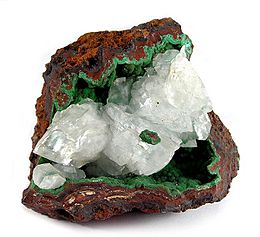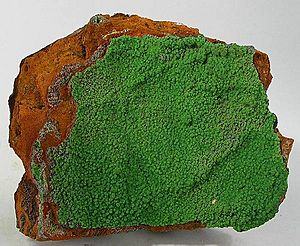Conichalcite facts for kids
Quick facts for kids Conichalcite |
|
|---|---|

A thin crust of conichalcite on a rock.
|
|
| General | |
| Category | Arsenate minerals |
| Formula (repeating unit) |
CaCu(AsO4)(OH) |
| Strunz classification | 8.BH.35 |
| Dana classification | 41.5.1.2 |
| Crystal symmetry | P212121 |
| Unit cell | a = 7.39(1) Å, b = 9.23(1) Å, c = 5.83(1) Å; V = 397.66 ų; Z = 4 |
| Identification | |
| Color | Grass-green to yellowish green, pistachio-green, emerald-green; may be zoned; light green to yellowish green in transmitted light. |
| Crystal habit | Crusts of acicular to almost fibrous crystals. Also as botryoidal masses and compact crusts. |
| Crystal system | Orthorhombic |
| Twinning | Rare on {001} |
| Cleavage | Absent |
| Fracture | Uneven |
| Tenacity | Brittle |
| Mohs scale hardness | 4.5 |
| Luster | Vitreous, greasy |
| Streak | Green |
| Diaphaneity | Translucent |
| Specific gravity | 4.3 |
| Optical properties | Biaxial (+/-) |
| Refractive index | nα = 1.778 - 1.800 nβ = 1.795 - 1.831 nγ = 1.801 - 1.846 |
| Birefringence | δ = 0.023 - 0.046 |
| Pleochroism | Visible |
| Dispersion | Strong r < v to r < v moderate |
Conichalcite is a cool green mineral. Its chemical formula is CaCu(AsO4)(OH). This means it contains calcium, copper, arsenic, oxygen, and hydrogen. It's an arsenate mineral, which means it has arsenic combined with oxygen.
Conichalcite is often found in a bubbly, grape-like shape called botryoidal. It forms in places where metal deposits have reacted with air and water. You can often find it alongside other minerals like limonite, malachite, and adamite.
Contents
How Conichalcite Forms
Conichalcite forms in the oxidation zones of copper deposits. Think of it like rust forming on iron. In these zones, oxygen-rich groundwater reacts with copper minerals. This process creates new minerals, including conichalcite.
It often grows as a crust on rocks that are yellow or red, like limonite.
Mineral Families
Conichalcite is part of a solid solution series with another mineral called calciovolborthite. This means they are very similar minerals that can swap out some of their elements. In this case, conichalcite has more arsenic, while calciovolborthite has more vanadium. They are like two ends of a mineral family.
Where to Find Conichalcite
Conichalcite is found in many places around the world. Some notable locations include:
- US: Juab County, Utah; Lincoln and Lyon counties in Nevada; and Bisbee, Arizona.
- Mexico: Durango.
- Chile: Collahuasi, Tarapaca.
- England: Calstock, Cornwall and Caldbeck Fells, Cumbria.
- Spain: Andalusia.
- Namibia: Tsumeb.
What Conichalcite Looks Like
Conichalcite is usually a beautiful green color. It can be grass-green, yellowish-green, or even emerald-green. Sometimes, you might see different shades of green in the same piece, which is called being zoned.
It often forms as thin crusts made of tiny, needle-like crystals. It can also appear as bubbly masses or solid layers on rocks.
Mineral Properties
- Hardness: Conichalcite is fairly soft, with a hardness of 4.5 on the Mohs scale. This means you can scratch it with a steel knife.
- Luster: It has a vitreous (glassy) or greasy shine.
- Streak: If you rub it on a rough surface, it leaves a green streak.
- Density: It's quite dense, meaning it feels heavy for its size.
See also
 In Spanish: Conicalcita para niños
In Spanish: Conicalcita para niños


